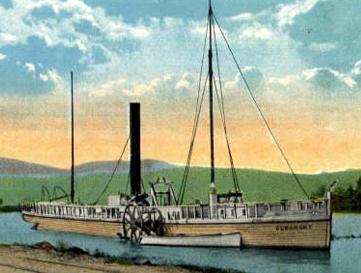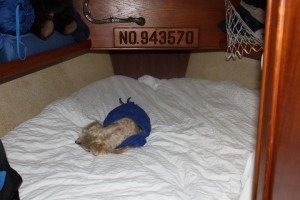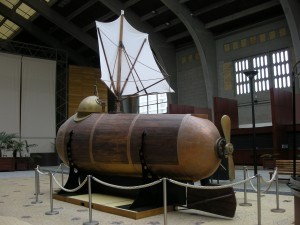Hot Air

Fulton's Steamboat - the Clermont
This week as the overnight lows hovered down around the low forties, I've become obsessed with the creation and benefits of hot air. I've been working as temporary labor at the Annapolis Sailboat Show to replenish my cruising kitty, and the cold mornings have seen me lighting the two burners and oven of my propane stove trying to heat up the cabin with sufficient hot air to dare take a shower.
But with no shore power (hence no hair dryer), my long wet hair is bloody freezing at 6:00 a.m. when I must row the Intrepid Seadog to shore. The problem with hot air is that it rises. I can only manage to heat up the top two feet of my cabin with toasty hot air. But I've now discovered that with all the burners going creating that layer of hot air at the top of the cabin, a 12V boat fan can make a pretty good stand-in for a hair dryer.
Back in the days when I lived aboard at the dock, I sometimes heated up my sheets at night with a hair dryer. You know the term "Three Dog Night" comes from country folk who used their dogs to warm up the bed, but since I only have one dog (and he wears his own jammies to bed)  and we've been having two dog nights here (pretty cold), I've learned that a hot water bottle can work just as well to produce hot dry sheets.
and we've been having two dog nights here (pretty cold), I've learned that a hot water bottle can work just as well to produce hot dry sheets.
Robert Fulton (1765 – 1815) was the American inventor who is credited with designing and building the first commercially successful steamboat — a vessel that ran on non other than HOT AIR (and hot water). She was called the Clermont and she took passengers up the Hudson from New York City to Albany in about 30 hours.
 What many people don't know about Fulton is that he also is credited with designing the first working submarine, The Nautilus. Fulton was trained and educated as an artist, but he began his work on boats while apprenticed to an artist in France. In 1801, he and three crewmen took the Nautilus down to a depth of 25 feet and stayed four four and a half hours. She had a hand cranked propeller for when she was underwater, a snorkel for air, and a weird junk-rig sail for when she was at the surface. While the British and the French were at war, and Fulton had devised a system for a carrying underwater bombs, he wasn't successful at selling his invention to either country. The French called him a charlatan and the English thought he was crazy. He returned to America a "failure." Although he later experienced tremendous success with his steamboats, Fulton died too young at age 49.
What many people don't know about Fulton is that he also is credited with designing the first working submarine, The Nautilus. Fulton was trained and educated as an artist, but he began his work on boats while apprenticed to an artist in France. In 1801, he and three crewmen took the Nautilus down to a depth of 25 feet and stayed four four and a half hours. She had a hand cranked propeller for when she was underwater, a snorkel for air, and a weird junk-rig sail for when she was at the surface. While the British and the French were at war, and Fulton had devised a system for a carrying underwater bombs, he wasn't successful at selling his invention to either country. The French called him a charlatan and the English thought he was crazy. He returned to America a "failure." Although he later experienced tremendous success with his steamboats, Fulton died too young at age 49.
My new novel CIRCLE OF BONES is also about a submarine that was built in France, and it was through research for that novel that I became fascinated with Fulton's place in the history of subs. He was a brilliant man, an artist and an inventor and during his life he was not afraid of trying new things and failing.
Last night, when I returned to my cold boat and started lighting my stove and seeking hot air, my iPad chimed with a news alert. I pressed the button and saw the news that Steve Jobs had died. Somehow, seeing those words on my iPad made the message all the more poignant and sorrowful. Another incredible genius artist and inventor who had the courage to risk failure (Apple fired him when he had just turned 30), someone who had changed my life and work profoundly had died too young.
The lives of both these men are great examples for those of us who are trying to navigate the perils of publishing in the 21st century. Going Indie and leaving the womb of traditional publishing is scary, and I have no idea if I will succeed or fail miserably. Will people read my self-published short stories and think they are nothing but more HOT AIR?
Last night, I climbed into my warmed bunk wearing an old T-shirt I got from Apple at a technology convention in 1998. These words are written on the back:
Here's to the crazy ones
Here's to the crazy ones.
The misfits.
The rebels.
The troublemakers.
The round pegs in the square holes.
The ones who see things differently.
They're not fond of rules.
And they have no respect for the status quo.
You can praise them, disagree with them, quote them,
disbelieve them, glorify or vilify them.
About the only thing you can't do is ignore them.
Because they change things.
They invent. They imagine. They heal.
They explore. They create. They inspire.
They push the human race forward.
Maybe they have to be crazy.
How else can you stare at an empty canvas and see a work of art?
Or sit in silence and hear a song that's never been written?
Or gaze at a red planet and see a laboratory on wheels?
We make tools for these kinds of people.
While some see them as the crazy ones,
we see genius.
Because the people who are crazy enough to think
they can change the world, are the ones who do.
From Apple Computer
Thanks for changing my world, Steve.
Fair winds!
Christine
Share on Facebook



